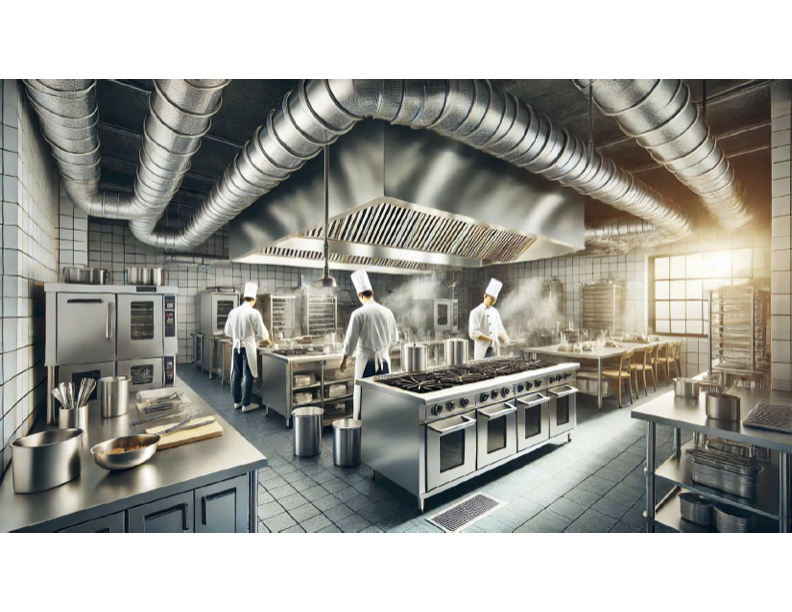Running a commercial kitchen is no small feat. From keeping up with customer demand to maintaining food safety and hygiene, there are countless factors that contribute to a successful operation. One of the most critical yet often overlooked aspects of a well-functioning kitchen is ventilation. The right commercial kitchen ventilation system doesn’t just improve air quality—it plays a vital role in safety, efficiency, and overall business success.
In this post, we’ll explore why investing in the right commercial kitchen ventilation system is a game-changer and how it impacts health, safety, productivity, and compliance.
1. Improved Air Quality & Health Benefits
A commercial kitchen generates large amounts of heat, smoke, grease, and airborne contaminants that can create an unhealthy working environment. A high-quality ventilation system effectively removes these pollutants, leading to cleaner, fresher air for employees and customers alike.
- Reduces carbon monoxide and harmful gas buildup
- Prevents lingering grease and food odors from spreading
- Enhances air circulation, reducing the risk of respiratory issues
Cleaner air doesn’t just make for a more comfortable kitchen—it also ensures better health for staff, reducing sick days and improving overall well-being.
2. Fire Prevention & Safety Compliance
Grease-laden air is a major fire hazard in any kitchen. Without a proper ventilation system, grease accumulates in ducts, hoods, and vents, increasing the risk of kitchen fires. A well-designed commercial ventilation system includes:
- High-quality exhaust hoods that capture grease and smoke
- Fire suppression systems integrated with the ventilation setup
- Routine cleaning & maintenance to prevent grease buildup
By keeping your ventilation system in top shape, you comply with fire codes and safety regulations, reducing risks and potential legal issues.
3. Better Temperature Control & Employee Comfort
Anyone who’s worked in a busy kitchen knows how hot it can get. Without a good ventilation system, heat and humidity can quickly become unbearable, leading to:
- Overheated kitchen staff, causing fatigue and heat exhaustion
- Reduced productivity due to discomfort
- Increased HVAC costs as air conditioning works overtime
A well-ventilated kitchen maintains a comfortable temperature, making it easier for chefs, cooks, and other staff to focus on their tasks without being drenched in sweat.
4. Energy Efficiency & Cost Savings
An inefficient ventilation system can send your energy bills skyrocketing. Modern ventilation solutions are designed with energy efficiency in mind, offering:
- Variable speed exhaust fans that adjust based on cooking activity
- Heat recovery systems that reuse excess heat to save on energy
- Efficient air replacement systems that maintain balance without overworking HVAC systems
Investing in smart ventilation technology can cut down on energy consumption and operating costs in the long run.
5. Compliance with Health Codes & Regulations
Regulatory bodies like OSHA, NFPA, and local health departments set strict ventilation requirements for commercial kitchens. A subpar system can result in:
- Failed health inspections and hefty fines
- Shut down operations due to non-compliance
- Negative customer reviews if odors and poor air quality affect dining areas
Choosing the right ventilation system ensures your business remains compliant and avoids unnecessary legal or operational setbacks.
Choosing the Right Ventilation System for Your Kitchen
When selecting a commercial kitchen ventilation system, consider:
✅ Type of Cooking – Heavy-duty grills and fryers require more powerful exhaust systems than a bakery or coffee shop.
✅ Hood Design – Choose between Type 1 (grease and smoke removal) and Type 2 (heat and moisture control) based on your needs.
✅ Airflow Balance – Properly balancing exhaust and make-up air prevents negative air pressure issues.
✅ Maintenance Requirements – Easy-to-clean systems help reduce fire risks and ensure compliance.
Final Thoughts
The right commercial kitchen ventilation system isn’t just a requirement—it’s an investment in safety, efficiency, and the longevity of your business. From maintaining air quality to reducing fire risks and improving employee comfort, proper ventilation keeps your kitchen running smoothly.
If you're planning to upgrade or install a new system, work with a professional ventilation expert to ensure your kitchen meets all necessary standards while maximizing efficiency and cost savings.
Got questions about choosing the best ventilation for your commercial kitchen? Send us a message or reach out to a Reliable Kitchen Hood specialist today!

